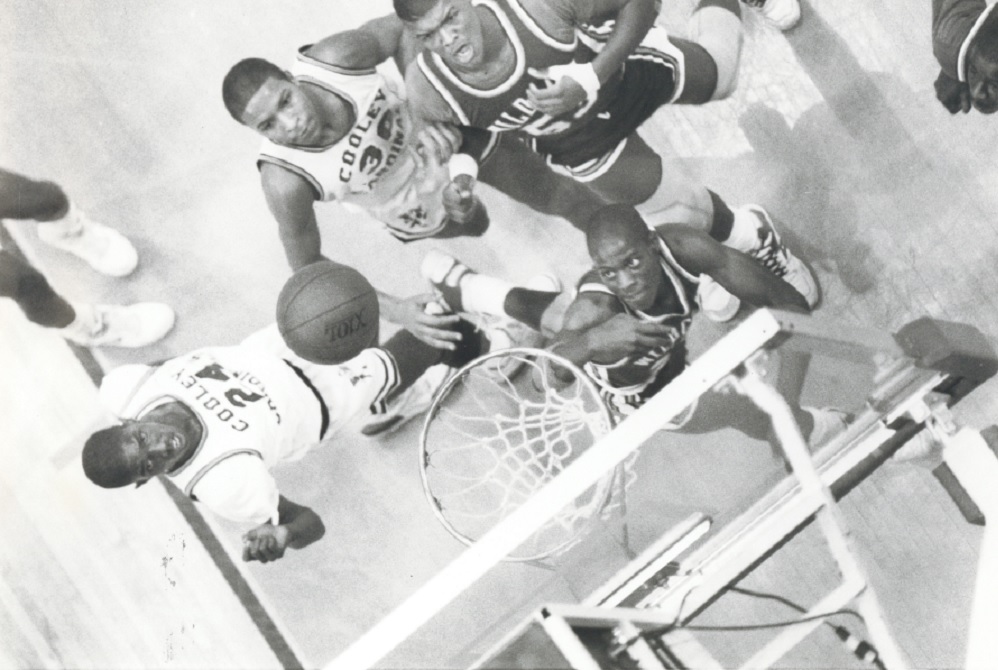
1970-1995: Detroit, Flint Ruled Class A Boys Basketball
By
Ron Pesch
MHSAA historian
March 7, 2022
Geographic domination.
It really hasn’t happened on the basketball court in the MHSAA’s top classification since the mid-1990s.
Class A state titles – designated Division 1 in basketball since 2019 – have bounced around Michigan over the last 25-plus years like, well, an over-inflated wayward basketball. Kalamazoo Central, Pontiac Northern, and Clarkston grabbed back-to-back titles between 1996 and 2021. The Saginaw area locked down five Class A crowns within that stretch; Arthur Hill snagged one in 2006, while Saginaw High immediately followed with two in a row in 2007 and 2008. The Trojans also won in 1996 and 2012. Greater Lansing has three titles – one by Lansing Everett, another by Lansing Waverly, then one by Holt High School – about eight miles outside the city limits.
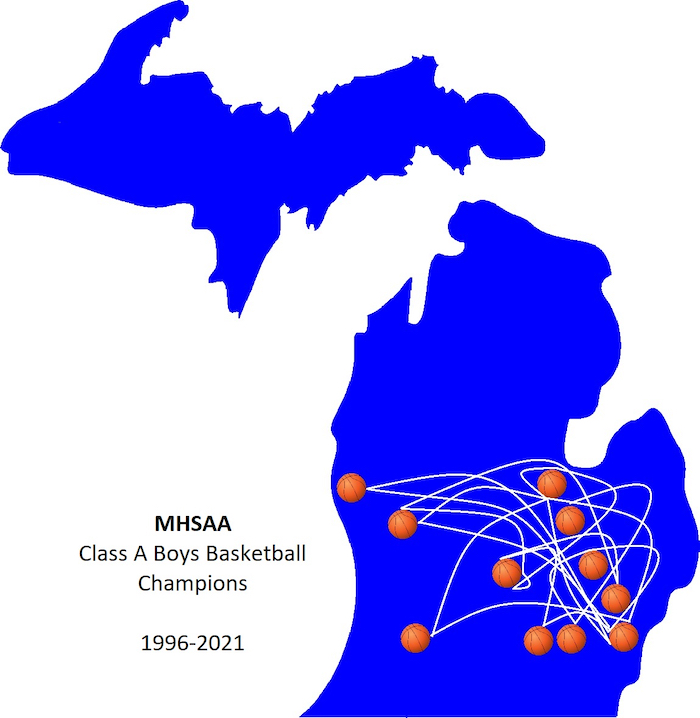 Then it’s single titles to Grand Rapids Ottawa Hills, Rockford, Muskegon, Ann Arbor Pioneer, and Ypsilanti Lincoln. Metro Detroit schools Romulus, Pershing, Central, Western, and U-D Jesuit also have single championships during that span.
Then it’s single titles to Grand Rapids Ottawa Hills, Rockford, Muskegon, Ann Arbor Pioneer, and Ypsilanti Lincoln. Metro Detroit schools Romulus, Pershing, Central, Western, and U-D Jesuit also have single championships during that span.
But from 1970 to 1995, a trip to the Finals to watch the ‘A’ title game meant – with rare exception – you were watching a team from Flint or Greater Detroit. Or both.
Flint: Home of the Vikings
Opened in the fall of 1928, Flint Northern had been the Vehicle City’s top basketball school, winning Class A titles in 1933, 1936, 1939, and 1940 under coach Jim Barclay, then another in 1947 under Les Ehrbright. The Vikings also advanced to the state championship game in 1954 under Carl Stelter, losing to Muskegon Heights in overtime, 43-41.
Then, things went mostly quiet for the next decade and a half.
Jack Marlette was only the fourth varsity basketball coach in school history. Since arriving at Northern in 1949, he had served as head coach in tennis and golf, sophomore coach in basketball and football, junior varsity coach in basketball and football, equipment manager, and head trainer.
Midseason 1955, he replaced Stelter as the varsity basketball coach, when Stelter was named a principal within the Flint school district.
“Marlette coached teams posted a record of 112 victories and 99 defeats,” stated Len Hoyes in the Flint Journal when the coach stepped down in March 1967. “Included are six city championships, two districts, and a Saginaw Valley Conference crown in 1956.” His 1957 team reached the MHSAA Quarterfinals, losing to East Detroit.
With the announcement, Northern wooed 36-year-old Dick Dennis to take his spot come the 1967-68 season. Dennis’ teams had posted an impressive 105-21 varsity record at Alpena High School over seven seasons. Perhaps more impressively, his teams had beaten two of the Flint area’s finest in the MHSAA Regional round in 1966.
Dennis agreed to the move to Northern, “but had one important request,” stated reporter Bruce Johns in the Journal. “He wanted Bill Frieder as the junior varsity coach.”
Frieder, who would ultimately become a legendary basketball figure in Michigan, had landed his first basketball job as JV coach under Dennis at Alpena during the 1965-66 school year.
“… (A) son-in-law of Larry Laeding, former Saginaw High coach and a former player for the Trojans, Freiders (sic) had a 20-11 JV record for two years,” noted the Journal at the time of the hiring. (Laeding’s Saginaw team had won the Class A basketball championship in 1962.)
Dennis’ varsity squad posted an 11-6 record that first year, followed by a 13-6 mark in 1968-69, the program’s best season in 10 years. Frieder’s 1967-68 JV Vikings finished with a 13-3 mark, earning a share of the Saginaw Valley Conference’s title. In his second year, Frieder’s squad went a flawless 16-0.
But a teacher’s strike in Flint the following school year caused Frieder to resign from his position.
“At this point, I want to emphasize that I am highly opposed to teachers’ striking as I feel it sets a poor example for children and such an act reflects upon me personally,” stated Frieder in a letter of resignation to the Flint Board of Education.
Unable to work around it, he stepped aside.
Another shake-up
After three seasons at the helm, in May 1970, Dennis accepted an assistant principal position within the district. Northern administration interviewed nine “capable” candidates for the opening, including the former JV coach.
“Out of the candidates, we felt that Bill was the best qualified,” Northern athletic director Jim Fowler told the Journal’s Dean Howe 22 days later. “Bill is familiar with our situation at Northern, he’s familiar with the kids and unquestionably a fine coach.
“… it was Dennis’s strong recommendation that finally swung the gavel Frieder’s way,” stated Howe.
“Bill has a tremendous ability to get along with the kids,” Dennis had told the Journal in 1969. “… there are some coaches who never accomplish this. Bill’s two outstanding characteristics are his loyalty to the job and kids and his tremendous amount of pride.
“He just loves the game. Bill works just as hard at developing good citizens as he does to winning.”
Under Frieder, the Vikings quickly returned to the state spotlight, winning two straight MHSAA Class A championships in 1971 and 1972.
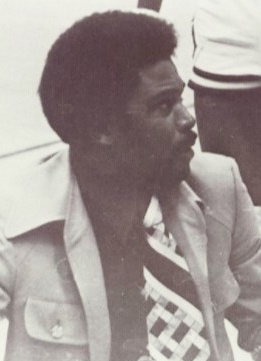 For the first time since 1954, Northern enjoyed final round success. Frieder’s 1971 Vikings, powered by senior Tom McGill and the Britt brothers, Wayman and James, clipped the taller – and favored – crew from Detroit Kettering, led by Lindsay Hairston, 79-78.
For the first time since 1954, Northern enjoyed final round success. Frieder’s 1971 Vikings, powered by senior Tom McGill and the Britt brothers, Wayman and James, clipped the taller – and favored – crew from Detroit Kettering, led by Lindsay Hairston, 79-78.
A year later, Frieder’s team beat Pontiac Central, a squad it had defeated twice during the regular season, 74-71. It was the Vikings’ 33rd-straight victory.
Frieder returned for the 1972-73 season. The Vikings posted an 18-7 record and won a District title. In July, his JV coach from the past two seasons, Grover Kirkland, was named head basketball coach at Flint Northwestern. In August, Frieder resigned. Rumors had been flying that he might go to the University of Michigan as an assistant. A Saginaw native, Frieder stated his “retiring is a result of many things.” Primarily, he planned to return to Saginaw to go into the produce business with his father.
The rumors, it turned out, were true. A little over a month later, the University of Michigan appointed Frieder as assistant basketball coach.
“We think it’s very fine to have a man of Bill’s caliber on our staff,” said Johnny Orr, Michigan’s head men’s basketball coach.
“If at this point in my life, I could describe the job I wanted most, the thing I wanted most to do in my life, this would fit it to a tee,” said Frieder at the time of the announcement.
Bill Troesken, 29, who had stepped down in June of 1973 after three years as varsity coach at Flint Powers Catholic, was hired by Northern to replace Frieder. His team would grab another Class A championship in March 1978.
A Long Drought
Flint’s oldest high school, Flint Central, was opened in 1875. Incredibly, the boys basketball team never won a state title – or even appeared in a championship game – until coach Stan Gooch arrived on the scene.
“Gooch, who starred in basketball at Flint Tech High, Flint Junior College, and Central Michigan (University), began his coaching career as bench boss of the sophomore team at Central High in 1959,” recalled Brendan Savage for MLive in 2008 at the time of his induction into the National High School Athletic Coaches Association Hall of Fame. “He took over the reins of the junior varsity the following year and was promoted to varsity coach in 1966.” Gooch guided Flint Central to its first state championship game in 1967, but Central was trounced by Detroit Pershing, a PSL squad considered by many to be the greatest basketball team in Michigan prep history. Guided by coach Will Robinson, the Doughboys were led on the court by future NBA players Spencer Haywood and Ralph Simpson.
Gooch resigned following the 1967-68 season to become head coach at Flint Junior College (which was converted into a countywide college, and rebranded as Genesee Community College in 1969, then renamed Mott Community College in 1973). After 10 seasons, Gooch stepped down, and within months, he replaced his replacement at Flint Central, Clif Turner, who had guided the program through the 1977-78 season.
Central then won three straight Class A titles from 1981-83, helping to build the legend of Flint basketball.
Then it was Northwestern’s turn. In both 1984 and 1985, Coach Kirkland’s Wildcats beat Detroit Southwestern. With those wins, the Flint city schools had now won six of the last eight titles.
“City of Champions defies explanation” trumpeted the Journal at the end of March 1985, after Northwestern had won Class A and Flint Beecher had won the boys title in Class B.
“No single factor can be pinpointed as the reason Flint has dominated,” wrote Phil Pierson under the headline, “while metropolitan Detroit, an area approximately 10 times larger, has failed to win a Class A Championship since 1979.”
Northwestern’s Glen Rice “became the area’s first recipient of the Mr. Basketball award presented by the Michigan High School Basketball Coaches Association and has been named to the Parade and Basketball Weekly All-American teams. (Beecher’s Roy Marble finished second, while Central’s Terence Greene finished fourth in Mr. Basketball balloting).
Was this success the opportunity to play year-round, asked Pierson. Coaching? The talent on the court?
Other areas across the state featured these same strengths, concluded the writer. “It may just be that the reason for Flint’s success is too obvious to be considered by the philosophers: the cyclical nature of high school sports.
“There was nothing wrong with Flint basketball from 1948-70 when there were no state Class A or B championships. Other teams and programs were just better.”
The Return of the PSL
It took five years after the return to the MHSAA Tournament before the PSL earned a Class A title with that ’67 Pershing squad. The next arrived in 1970, again by Pershing, then in 1973 by Southwestern, and again in 1979 by Mackenzie. Class A was won by Metro Detroit in 1974, by Birmingham Brother Rice, in 1975 by Highland Park, and in 1976 by Detroit Catholic Central.
From 1971 to 1985, Flint’s public school champions had defeated Pontiac Central twice, and PSL teams from Kettering, Murray-Wright, and, famously, Southwestern, on four straight occasions between 1982 and 1985.
On only two occasions between 1975 and 1995 did the Class A crown leave the city of Flint or Metro Detroit. In both instances, it landed in Lansing. In 1977, the Lansing Everett Vikings, led by Earvin Johnson – nicknamed “Magic” by the press – wrestled it away by downing Brother Rice in a 60-56 overtime thriller. In 1980, Lansing Eastern, powered by the state’s first Mr. Basketball winner, Sam Vincent, did the same, with a 64-53 victory over Highland Park.
The Cycle of Basketball
As soon as the ink dried on Pierson’s words, it seems, the cycle rotated.
Romulus took down Southwestern in ’86 before the PSL took control of Class A beginning with the 1987 season. Cooley, coached by Ben Kelso, snagged the first of three straight that year. After finishing as runner-up in seven of the previous eight title games, Southwestern, coached by Perry Watson, grabbed back-to-back victories in ’90 and ’91. Coach Johnny Goston’s Pershing teams beat Benton Harbor for consecutive titles in 1992 and 1993. Then Murray -Wright, coached by Robert Smith, captured its first crown in 1994.
On four of the eight occasions between 1987 and 1994, the Class A game featured an all-PSL card.
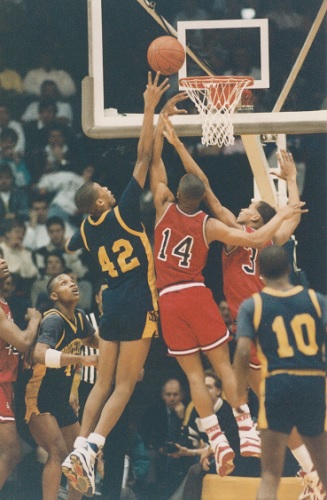 The 1995 Class A final wrapped the amazing run as No. 1-ranked Flint Northern, powered by Mateen Cleaves’ game-leading 28 points and Antonio Smith’s 24 points and 15 rebounds, decimated No. 2 Pershing, 86-64 before a crowd of 11,179 at the Breslin Center. Northern had trailed 44-37 at the half.
The 1995 Class A final wrapped the amazing run as No. 1-ranked Flint Northern, powered by Mateen Cleaves’ game-leading 28 points and Antonio Smith’s 24 points and 15 rebounds, decimated No. 2 Pershing, 86-64 before a crowd of 11,179 at the Breslin Center. Northern had trailed 44-37 at the half.
It was Northern’s first title since 1978. It would also be the program’s last. The introduction of “school of choice” in Michigan in 1996, combined with plunging birth rates in the U.S. that peaked in 1978, meant upheaval in enrollment across the state’s public schools. In Flint, declining enrollment – also impacted by the pending closure of a massive automotive manufacturing complex operated by General Motors known as “Buick City” – forced the closure of Central following the 2008-09 school year. Northern closed in 2013. Following the 2017-18 school year, Northwestern and Flint Southwestern merged, leaving Southwestern as the city’s lone high school.
In Detroit, Northern, Mackenzie, and Murray-Wright were among four high schools closed by the Detroit Public Schools in 2007 due to cost constraints and declining enrollments. Cooley was shuttered in 2010. Southwestern, dedicated in 1922, and Kettering, opened in 1965, both closed in 2012.
Of the 26 Class A title games waged between 1970 and 1995, Flint City Schools and the PSL teams each won nine of those contests. On 15 occasions, the championship game featured a match-up of Flint and Detroit PSL teams. On only seven occasions did schools from outside Wayne, Oakland, or Genesee counties ever crash the championship party. Saginaw High School ended with runner-up honors in 1973, 1976, and 1990, with Lansing and Benton Harbor High Schools being the only others.
Parade of Talent
Basketball junkies attending title games during those years watched an incredible collection of talent come out of those teams from Flint, the PSL and metropolitan Detroit during the span.
On the coaching side:
► Frieder ended up as head coach at Michigan with the 1980-81 season, then Arizona State in 1989.
► Gooch compiled over 400 varsity wins and 86 JV victories during his time at Flint Central.
► Kirkland ended his basketball coaching career in 2000 as Flint’s all-time winningest varsity coach, compiling a 518-148 mark. His Wildcats compiled 60-straight wins between January 1984 and February 1986 and presently rank No. 3 in consecutive wins in state history. In 2020, Detroit Free Press writer Mick McCabe named Northwestern’s 28-0 team from 1985 as the greatest boys basketball team he covered in his 50 years of reporting.
► Southwestern’s Watson served as an assistant at Michigan for two seasons, then guided the men’s basketball team at the University of Detroit Mercy from 1993 to 2008, compiling a 258-185 record over 15 seasons.
► Kelso, a Flint Southwestern graduate who did not play high school basketball but ended up as the all-time scorer at Central Michigan when he graduated in 1973, would be a finalist for the head coaching spot at CMU in 1997. At Cooley from 1984 through 1998, he later served as an assistant basketball coach at Kansas State in 2005-06.
► Kettering’s Charles Nichols, on hand since the school opened, coached tennis, football, and track during his first years at the school. With the 1970-71 season, he took over basketball coaching duties from Walt Jenkins, guiding the team for four campaigns. In December 1974, he joined Dick Vitale’s coaching staff at the University of Detroit for parts of two seasons. He returned to Kettering in 1978 as athletic director, then later served as assistant director of the PSL until his retirement in 2002.
The players included:
Flint
► Central’s Eric Turner, Marty Emery, Mark Harris, Keith Gray, Terence Green, and Darryl Johnson.
► Northern’s Terry Furlow, Dennis Johnson, Gary Pool, Antonio Smith, and Mateen Cleaves.
► Northwestern’s James Person, Jeff Grayer, Glen Rice, Andre Rison, Anthony Pendleton, and Daryl Miller.
Detroit PSL
► Cass Tech’s Tony Jamison and William Mayfield.
► Cooley’s Yamen Sanders, Earl Stark, Rafael Peterson, Michael Talley, and Daniel Lyton.
► Kettering’s Lindsay Hairston, Joe Johnson, Eric Money, and Coniel ‘Connie’ Norman.
► Mackenzie’s Steve Caldwell and Dave Traylor.
► Murray-Wright’s Willis Carter and Robert Traylor.
► Northern’s Katu Davis and Leonard Bush.
► Pershing’s Phil Paige, Robert Hawkins, Calvin Harper, Willie Mitchell, Carlos Williams, Todd Burgan, and Winfred Walton.
► Southwestern’s Darryl Robertson, Antoine Joubert, Clarence Jones, Sam Sillmon, Tarence Wheeler, Anderson Hunt, Loren Clyburn, James Hunter, Jalen Rose, Voshon Lenard, and Howard Eisley.
Metro Detroit
► Birmingham Brother Rice’s Will Franklin, Kevin Smith, and Tim Andree.
► Detroit Catholic Central’s Mike Prince and David Abel.
► Highland Park’s Terry Duerod, Percy Cooper, and Renardo Brown.
► Pontiac Central’s brothers Campy, Larry and Walker D. Russell; Larry Cole, Tim Marshall, and Clyde Corley.
► Romulus’s Terry Mills, and Stevie Glenn.
 Ron Pesch has taken an active role in researching the history of MHSAA events since 1985 and began writing for MHSAA Finals programs in 1986, adding additional features and "flashbacks" in 1992. He inherited the title of MHSAA historian from the late Dick Kishpaugh following the 1993-94 school year, and resides in Muskegon. Contact him at [email protected] with ideas for historical articles.
Ron Pesch has taken an active role in researching the history of MHSAA events since 1985 and began writing for MHSAA Finals programs in 1986, adding additional features and "flashbacks" in 1992. He inherited the title of MHSAA historian from the late Dick Kishpaugh following the 1993-94 school year, and resides in Muskegon. Contact him at [email protected] with ideas for historical articles.
PHOTOS (1) Detroit Cooley's Rafael Peterson (24) and Benson Maurice match up with Flint Northwestern's Archie Munerlyn (53) and Reggie Richardson during the 1988 Class A Final. (2) The Class A/Division 1 championship has been won by teams across the southern half of the Lower Peninsula over the last 25 years. (3) Grover Kirkland, here in 1975, built Flint Northwestern into a power. (4) Detroit Southwestern's Jalen Rose (42) and Cooley's Michael Talley (14) work to grab a loose ball during the 1989 Class A Final. (Photos courtesy of the Detroit News [1] and Gary Shook [4], or collected by Ron Pesch.)
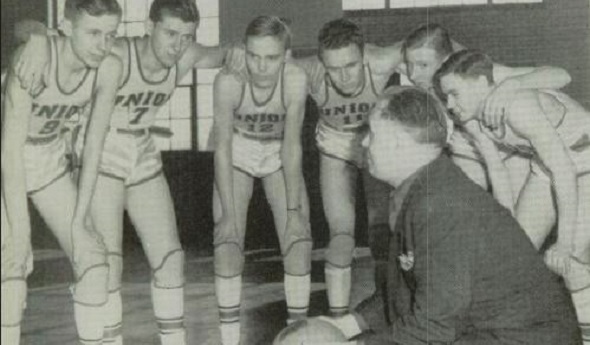
The Last Time MHSAA Finals were Canceled
By
Ron Pesch
MHSAA historian
April 27, 2020
Historians trace the start of World War II to German dictator Adolph Hitler’s decision to invade Poland on September 1, 1939. The Empire of Japan’s involvement in the war became effective in September 1940 with the signing of the Tripartite Pact.
Until December 7, 1941, the United States avoided official involvement, declaring themselves “a neutral nation.” Then came Imperial Japan’s bombing of Pearl Harbor.
A labor shortage caused by World War I had taken out spring high school sports in Michigan in 1917. As noted in the Second Half article, “1918 Pandemic, WWI Threatened High School Sports,” the global spread of a devastating strain of influenza interrupted the football season in Michigan. Prep athletics would roar through the 1920s and survive the Great Depression before seeing another interruption.
That next disturbance had nothing to do with war’s insatiable desire for manpower. Rather, it was because of tires.
“When the Japanese bombed Pearl Harbor, rubber instantly became the most critical strategic material for making war,” wrote Stephen W. Sears in the October/November issue of American Heritage magazine in 1979. “Nine-tenths of the nation’s rubber came from the Far East, and it was painfully evident that nothing would now stop Japan from cutting off that source.”
Americans consumed nearly two-thirds of the world’s production of rubber. With only about a year’s worth of material on hand, “Just four days after Pearl Harbor a freeze was put on the sale of new passenger-car tires,” stated Sears, “and on December 27 tire rationing was authorized, to go into effect early in January, 1942. Sales of new cars also were halted.”
The MHSAA
The Michigan High School Athletic Association arrived in December 1924. It replaced the old Michigan Interscholastic Athletic Association which had served Michigan for 15 years.
The organization’s primary purpose was to standardize, interpret and administer rules, educate and guide officials, and regulate student eligibility within prep sports in Michigan. By the 1940s, it had evolved into an association that also managed postseason tournaments, designed to identify state champions in specific sports: swimming, cross country, golf, tennis, track, and the sport sponsored by the most high schools in the state, basketball.
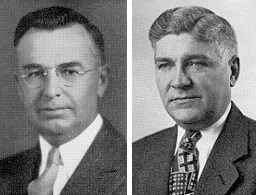 “The old MIAA had taken over the regulation of basketball tournaments in 1920. This had been done as a service to the schools and especially as a means of eliminating evils inherent in the invitational tournaments (that were hosted by various colleges around the state and the midwest),” wrote Lewis L. Forsythe in his book, Athletics in Michigan High Schools, recalling the first 100 years of prep sports in the state.
“The old MIAA had taken over the regulation of basketball tournaments in 1920. This had been done as a service to the schools and especially as a means of eliminating evils inherent in the invitational tournaments (that were hosted by various colleges around the state and the midwest),” wrote Lewis L. Forsythe in his book, Athletics in Michigan High Schools, recalling the first 100 years of prep sports in the state.
“In the last days of February 1942,” multiple Michigan schoolmen were in San Francisco to attend the annual meetings of Secondary School Principals, Superintendents and the National Federation of State High School Associations. “We were well aware that many of our boys in school would have to offer themselves in the service of their country,” noted Forsythe in his publication. “We fully realized that the quality of that service and, indeed, their own survival might well depend quite as much on their physical fitness as on their intellectual and spiritual resources. It was under those circumstances that we determined so to modify the emphasis of our athletic program as to make the largest possible contribution to the war effort. We recognized that the need in Michigan could not be met by our organization alone, and we therefore determined to encourage a general enrollment of all school groups in a united effort for promotion of physical fitness.”
Because of the “scarcity of tires and automobiles,” in April 1942 the MHSAA announced plans to curtail their upcoming annual golf and tennis events, eliminating a state championship round. Instead, the seasons were concluded with separate eastern and western sectional tournaments, hosted in Ann Arbor and Grand Rapids.
Early in May of 1942, MHSAA executive director Charlie Forsythe, nephew of Louis Forsythe, announced that the Association was “working on plans designed to make body-building exercises available to more young men and to spread recognition of sports achievements. He predicted substantial growth of intramural sports to include youngsters whose limited prowess might keep them from such interscholastic sports as football, baseball or basketball.”
Wire articles had told the story of how the running Battle of the Atlantic had impacted U.S. ocean transportation along the eastern seaboard. A Germany-mounted “campaign against American coastal shipping” by U-boats (submarines) was devastating “a section of America almost exclusively dependent upon ocean-point tankers for its petroleum products.” Without a viable alternative means to transport the products, on May 15, 1942, gasoline rationing began in 17 seaside states and the District of Columbia. It was hinted that gas rationing – specifically designed to save rubber – could roll out nationally. (Crude oil is the main ingredient in man-made rubber.)
The chances for restrictions in Michigan were a distinct possibility. According to P.J. Hoffmaster, the state’s supervisor of wells, the state consumed approximately 140,000 barrels of oil per day, but produced only 64,054 barrels. “This state has a shortage of at least 100,000 barrels on the basis of a regional demand,” he said, noting Michigan oil also supported needs outside the state. “When people say there can’t be rationing in Michigan because we have plenty of our own oil, they don’t have the true picture.”
Reverberations begin
When quizzed on the subject before the annual Lower Peninsula Track and Field championships, hosted at Michigan State College in May 1942, (Charlie) Forsythe, told The Associated Press he was unsure how rationing might affect the Association’s annual playoffs.
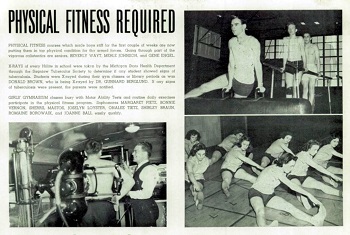 “It is too early as yet to say exactly. … We are making every effort to maintain an adequate athletic program. Certainly where common carriers (busses and trains) will make it possible to get a team to a game, that means should be used,” Forsythe said. He added that the Association was “surprised to find the number of schools competing in this year’s tournaments practically equaled last year’s entries.”
“It is too early as yet to say exactly. … We are making every effort to maintain an adequate athletic program. Certainly where common carriers (busses and trains) will make it possible to get a team to a game, that means should be used,” Forsythe said. He added that the Association was “surprised to find the number of schools competing in this year’s tournaments practically equaled last year’s entries.”
A total of 162 schools had qualified individual contestants in the track championships, about 10 percent fewer than in 1941. However, L.L. Frimodig – the assistant director of college athletics at M.S.C. and acting director of the state track meet – felt “the actual field in the four-class carnival would be much smaller than the number eligible to compete,” considering the circumstances of travel. “Many coaches,” he said, “would think in terms of tires rather than trophies before embarking on any sizable journey to the meet.”
The threat of rationing was almost immediately seen within Michigan’s resorts and travel industry.
“July and August have been moved up into June,” wrote the Detroit Free Press. “This is the word that comes from various parts of the state. Evidently, determination to get the vacation over before gas rationing may be decreed is one of the factors that has stepped up the season. … Reports of heavy patronage at nearby resorts over Memorial Day week-end can be taken as an indication of the trend, or necessity in 1942 of holidays enjoyed close to home base.”
Come September, Joseph B. Eastman, national director of the office of war transportation, called for help in reducing consumption of natural resources: “We intend to solicit the help of colleges and universities in making arrangements for transfer of scheduled games to centers of population where as many people as possible will have an opportunity to attend football games without traveling.”
At the college level, the freshman eligibility rule was waived due to the loss of manpower tied to military enlistment and the enactment of the Selective Training and Service Act of 1940. Its passage required all men between ages 21 and 45 to register for the first peacetime draft in U.S. history. With entry into the war, in December 1941, it was amended to require all 18 to 64-year-olds to register, with starting age for likely draft lowered to 20.
“The seasons of 1942-45 turned the (college) game upside down, creating new juggernauts and decimating some old ones,” wrote Sports Illustrated in its 1971 article, “When Football Went to War.”
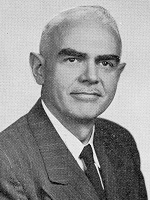 “Michigan’s 85 high school athletic leagues are speculating on the effects of the office of defense transportation plan to whittle sports travel drastically,” stated an Associated Press (AP) article soon after Eastman’s announcement. The Southwestern Conference, comprised of Kalamazoo Central, Benton Harbor, Muskegon, Holland, Grand Haven and Muskegon Heights and one of the most widely spread major prep circuits in the state, was told by its regular bus company that its busses were not available for charter.
“Michigan’s 85 high school athletic leagues are speculating on the effects of the office of defense transportation plan to whittle sports travel drastically,” stated an Associated Press (AP) article soon after Eastman’s announcement. The Southwestern Conference, comprised of Kalamazoo Central, Benton Harbor, Muskegon, Holland, Grand Haven and Muskegon Heights and one of the most widely spread major prep circuits in the state, was told by its regular bus company that its busses were not available for charter.
On Sept. 25, according to AP, “the state department of public instruction warned today that a threat of ‘no new tires’ will be held over rural schools which use their school busses to transport football players to and from games.”
Julian W. Smith, named the interim director of the MHSAA when Charlie Forsythe went into military service, didn’t think the directive would have much impact on football schedules. “However, I believe the order will have a serious effect on basketball schedules this winter and on next year’s football schedule.”
“Four Gallons a Week for Most Drivers”
Two days later it was announced that nationwide gas rationing would go into effect at the beginning of December 1942. More immediately, compulsory tire inspections every 60 days and a “Victory Speed Limit” of 35 miles per hour, effective Oct. 1, were also enacted. “This is not a gasoline rationing program, but a rubber conservation program,” said William M. Jeffers, president of the Union Pacific Railroad, which had been placed in charge of the government’s struggle to alleviate the rubber shortage.
“The object is not to take cars off the road, but to keep them on the road. … The safe life of a tire at 50 miles per hour is only half as great as it is at 30 m.p.h.”
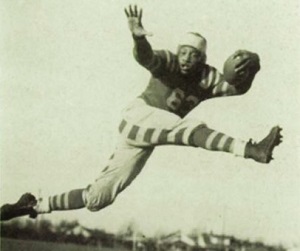 After initial announcements of game cancellations, the impact on high school football in Michigan in 1942 appears to have been minimal. Solutions were found to most challenges. In Bessemer, the high school superintendent announced that “enough persons have volunteered their automobiles to take the Speed Boy players to Calumet” for the game, scheduled for Saturday, Oct. 3. At season’s end, Flint Northern, Detroit Catholic Central, Muskegon, and Wyandotte each lay claim to a share of Michigan’s mythical football title.
After initial announcements of game cancellations, the impact on high school football in Michigan in 1942 appears to have been minimal. Solutions were found to most challenges. In Bessemer, the high school superintendent announced that “enough persons have volunteered their automobiles to take the Speed Boy players to Calumet” for the game, scheduled for Saturday, Oct. 3. At season’s end, Flint Northern, Detroit Catholic Central, Muskegon, and Wyandotte each lay claim to a share of Michigan’s mythical football title.
But a hint of what was to follow came with an announcement concerning the annual Cross Country Finals. The state meet was cancelled to reduce travel, with honors instead awarded during October meets to which schools were assigned based on geography.
In its October 1942 bulletin, the MHSAA endorsed a commando-type “training plan drafted by the Minnesota branch of the office of civilian defense” to “step up scholastic physical fitness programs.” When plotted on a football field, the course bordered the playing area with 11 obstacles spaced 20 yards apart. The course required participants to jump a 4-foot fence, crawl under a 2-foot-high rope, then run between a maze of stakes and, later in the course, high-step through a series of open boxes. Students would scale a 7½-foot wall, walk on a 12-foot balance beam, swing across a broad jump pit from a rope that hung from above, then climb another rope hung from the crossbar of the goal posts. Once accomplished, the participant was to move, hand-over-hand, across the span of the crossbar before dropping to the ground.
At the end of October, the MHSAA’s Representative Council acknowledged the direct contribution that interscholastic sports had on the “lives of students and citizens of the communities in which they are offered” while recommending that they be “retained insofar as possible.”
The committee, however, also emphasized its belief “that physical fitness programs for all students, and intramural sports to offer opportunity for competition to all, should be stressed in the schools’ athletics program.
“In all probability,” it continued, “it will be necessary to modify the general plans of conducting tournaments.” The mechanics of modification would be hammered out at the next Council meeting to be held in December in Lansing.
Financial concerns also were expressed, as much of the Association’s operating budget came from a share of gate receipts of tournaments.
The Impact
“All over the state, athletic directors and coaches are tackling transportation problems. Instead of piling the athletes into privately owned automobiles or school busses, coaches have diligently studied timetables of regular train and bus lines with many satisfactory results,” stated the AP on Dec. 4.
That same day, the MHSAA announced that the upcoming basketball postseason would be altered due to rationing. The story was picked up by various newspapers across the Midwest.
“The association’s Representative Council last night stressed need for following a ‘principle of minimum travel’ in basketball play this winter and voted to dispense with the annual Lower Peninsula finals,” instead opting for a modified layout. Initial conversation related to a plan calling for sectional meets with the possibility of naming titles in the northern half of the Lower Peninsula, and in both the southern and eastern areas. An appointed basketball committee was also to consider combining enrollment classifications wherever necessary to localize tournament play.
From 1932-1947, inclusive, separate Lower and Upper Peninsula basketball champions were determined. The Upper Peninsula Athletic Committee announced a similar plan at its meeting in January of 1943. The committee expected to present winners of the U.P. events with certificates instead of the customary trophies due to shortage of materials prompted by the war.
According to a survey of its 40 member state associations by the National Federation of State High School Associations, Michigan was one of only four states, including Maine, Montana and Nevada, to eliminate naming basketball state champions come the winter of 1943, “since the distances within those states are too vast or transportation facilities are too limited. The same will prevail in track contests.”
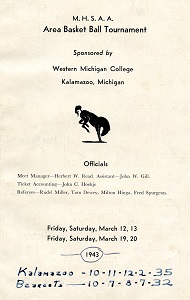 By mid-January, the MHSAA had polled its membership, and approximately 95 percent of the state’s high schools indicated a desire to participate in the replacement tournaments pitched by the Association. After examining the logistics, the plan previously discussed was modified. The Association then identified 51 Lower and 11 Upper Peninsula sites, based on availability to host the tournament and geographic suitability. The competition would run for two weeks, and end with what had previously equaled District championship contests.
By mid-January, the MHSAA had polled its membership, and approximately 95 percent of the state’s high schools indicated a desire to participate in the replacement tournaments pitched by the Association. After examining the logistics, the plan previously discussed was modified. The Association then identified 51 Lower and 11 Upper Peninsula sites, based on availability to host the tournament and geographic suitability. The competition would run for two weeks, and end with what had previously equaled District championship contests.
In the meantime, the annual swim championships were reduced to a one-day meet. Hosted at the University of Michigan, the meet would tax the endurance of individual swimmers, “since officials … decided to conduct semi-final events additional to the customary qualifying trials and finals.” That meant a swimmer entered in two events could compete six times during the day, with qualifying events in the morning, semifinals in the afternoon and finals swum at night. Perennial powers Battle Creek Central and Ann Arbor University High emerged as champions.
“The war to date has proved one thing conclusively – athletics in all schools must go on, for they serve to properly condition our young men for the bigger task ahead,” said MHSAA interim director Smith, speaking at an “annual football and basketball ‘bust’ for Lakeview High School” in Battle Creek in February 1943. Smith had served as principal at the high school for 14 years before taking over at the MHSAA. He “expressed regret” that the MHSAA had altered the various formats of the annual championships. According to coverage of the gathering in the Battle Creek Enquirer, “he intimated that it, along with all other forms of statewide competition, would be restored before another school year begins.”
Continued Chaos
The cities of Lansing and Kalamazoo played host to the most contingents, with 25 teams across the four enrollment classifications playing games at recently completed Lansing Sexton – the rechristened Lansing Central High School – and the Lansing Boys Vocational School. A total of 23 schools squared off at Western Michigan College of Education (now Western Michigan University).
As previously stated, transportation considerations meant some schools played above or below their normal classification to make things work. Ecorse, normally a Class B school, battled in the Class A tournament hosted at Dearborn Fordson. Benton Harbor, with Class A enrollment numbers, competed in the Class B tournament played across the St. Joseph River at St. Joseph High School instead of at the Kalamazoo Area tournament against similarly-sized schools.
A total of 128 area titles were awarded across the state’s two peninsulas. Decatur, the Class C state champion in 1942 with a 25-0 record, was the only team titlist to repeat in 1943, emerging with one of the “Area” crowns and extending its streak of victories to 41 consecutive. Also among the winners was Grand Rapids Union, a “cellar team in the regular season.”
“Although Union stood seventh in the city tally, the Red Hawks won the Area Tournament Crown in three smashing, spine-tingling battles,” stated the sports editor in the 1943 Aurora - Union’s yearbook. “In fast games the Hawks overcame Catholic and beat the Creston Bears … as well as whipping Davis Tech for their final victory.”
In April, the MHSAA confirmed that competition would end with area, city or conference meets in track, and again in tennis and golf, because of transportation, participation issues, and the “prospects of closing of some of the schools early.”
Various fans and media members grumbled about the unsatisfying conclusion to the prep sports calendars.
Hope
The coaching ranks were heavily hit by the war, as numerous mentors were tapped by the armed forces to lead physical fitness programs. Despite initial concerns, few “of the state’s 400 football-playing prep schools” dropped the sport come the 1943-44 school year. As it would turn out, because of the travel constraints, attendance increased as more and more sports fans turned to high school competition for entertainment.
Smith stated in October that he had “yet to find anyone who is definitely against bringing the (basketball) championship tournament back to life. There seems to be overwhelming sentiment in favor of the revival. The schools right-about face on the state cage classic which annually drew 700 prep teams and 11,000 players is explained by the fact coaches now feel the federal government is strongly in favor of any attempt to encourage or extend athletics. Last year schoolmen were not certain what the government’s attitude on sports would be and were hesitant about continuing athletics in pre-war style.”
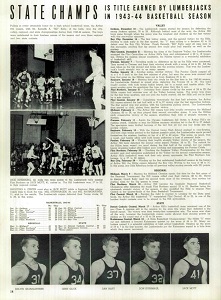 Only 258 of 614 schools replied to a questionnaire about restoring the winter basketball state championships, but 73 percent of respondents were in favor of such, and in December, the Representative Council voted to resume the final rounds of the tournaments.
Only 258 of 614 schools replied to a questionnaire about restoring the winter basketball state championships, but 73 percent of respondents were in favor of such, and in December, the Representative Council voted to resume the final rounds of the tournaments.
Born October 1918 in St. Johns, Michigan at the peak of the “Spanish Flu” pandemic, Hal Schram was a 25-year-old sports reporter for the Lansing State Journal when he covered the restart.
“State championship basketball and track competition once more became a part of (the) Michigan high school athletic program when the Representative Council of the MHSAA voted to reinstate these two state-wide tournaments after a suspension of one year,” he wrote.
According to Schram, “It was believed that student working hours, transportation, scarcity of balls and general lack of interest” still necessitated cancellation of golf and tennis tournaments for the year. Conduction of a swimming championship was left “in the hands of a committee representing schools which sponsor the sport … subject to the approval of the representative committee.”
Plans were to return the final rounds of the basketball tournament to Jenison Field House on the campus of Michigan State, which had hosted those rounds from 1940-42. However, the facility was in use by Army trainees for a physical fitness program.
“We would like to have the finals staged here very much,” said MSC athletic director Ralph Young, “but our obligations to the army come first.”
“Despite the hitch, the executive committee opted to stay in Lansing, playing Class A and C semifinal contests at the Boys Vocational School fieldhouse, and Class B and D semi games at Sexton High School. Finals were held at the Vocational gym.
“Fifty-five hundred spectators jammed their way into every nook and cranny of the Boys Vocational school fieldhouse last night to see four high school teams (Saginaw Arthur Hill, Marshall, Lansing St. Mary, Benton Harbor St. John) win championships in the Lower Peninsula tournament finals. With all seats taken almost before the first game started, the big floor was completely encircled by people sitting and standing before the finish,” wrote State Journal sports editor George S. Alderton. “By 6 o’clock, when the Class D game started, all seats in the side bleachers had been filled and most of the end bleachers were gone. The last vacancy was occupied before the Class C game started at 7:15 o’clock and from that time on, those who came either stood or seized a seat left by some departing fan. In many instances two sat down when one departed. Corners of the court were seething masses of humanity …”
United Press International wire reports indicated that 8,500 in total saw the Finals, as fans shifted in and out of the venue in support of the participating teams. “Some people had to be turned away at the finals,” said Smith, “and that certainly shows that people need and want this kind of relaxation.” The previous three Finals at MSC had drawn between 6,000-7,000 fans, while the 1939 Finals at I.M.A in Flint drew 5,000 and the 1938 event at Grand Rapids Civic Auditorium saw 6,000 attend.
“Lighting was so poor in the press box Friday night for the semi-finals,” added Alderton, “that workers came equipped with candles for the finals on Saturday night and propped them against their typewriters.”
Ishpeming hosted the Upper Peninsula Finals, as Escanaba, Crystal Falls, Channing and Amasa swept titles, respectively, in Classes B, C, D and Class E – the state’s smallest classification, reserved only for the smallest U.P. schools based on enrollment.
“Only complaint,” noted the Marquette Mining Journal, “was from those who couldn’t get in or were caught in a jam of fans seeking general admission seats. … Probably another 100 to 200 could have been accommodated if they were permitted to sit on the floor all along the court lines, but this would have been hazardous to players and fans …”
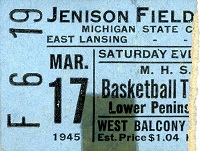 (The Lower Peninsula finals returned to Jenison in 1945 – where they stayed, uninterrupted, through 1970 – and were played before 7,833 spectators that first season back. Locals were delighted as they watched Lansing Sexton top Benton Harbor’s undefeated Tigers, 31-30. Michigan Governor Harry Kelly “personally presented the Class B championship trophy to Sturgis Capt. Tom Tobar, congratulated Capt. Larry Thomson of East Lansing and then shook hands with the captains of the Class A contest before the game started.”)
(The Lower Peninsula finals returned to Jenison in 1945 – where they stayed, uninterrupted, through 1970 – and were played before 7,833 spectators that first season back. Locals were delighted as they watched Lansing Sexton top Benton Harbor’s undefeated Tigers, 31-30. Michigan Governor Harry Kelly “personally presented the Class B championship trophy to Sturgis Capt. Tom Tobar, congratulated Capt. Larry Thomson of East Lansing and then shook hands with the captains of the Class A contest before the game started.”)
In mid-May, “some 800 Michigan prep trackmen, survivors of 40 regionals at 10 centers” headed to Michigan State College to determine statewide champs. Only Kalamazoo in Class A and Birmingham in Class B held the chance to “repeat” as team champions. Instead, Saginaw Arthur Hill capped a stellar sports year, earning its first Class A team track title to go with its recently-earned basketball crown. (Earlier in the school year, the Lumberjacks also had opened their own football field.)
East Grand Rapids earned its second track title, grabbing the Class B crown. Fowlerville and Glen Arbor Leelanau brought home titles in Class C and D, respectively.
All sports – including golf and tennis which had gone three years without competing in a true state title round – returned to their original formats with the start of the 1944-45 school year.
In May 1945, Germany surrendered to the Allies, followed by Imperial Japan’s surrender, announced in August.
Participation in prep sports and attendance numbers would explode across the state and the nation in the coming years, tied to multiple factors, including, of course, the baby boom that followed World War II.
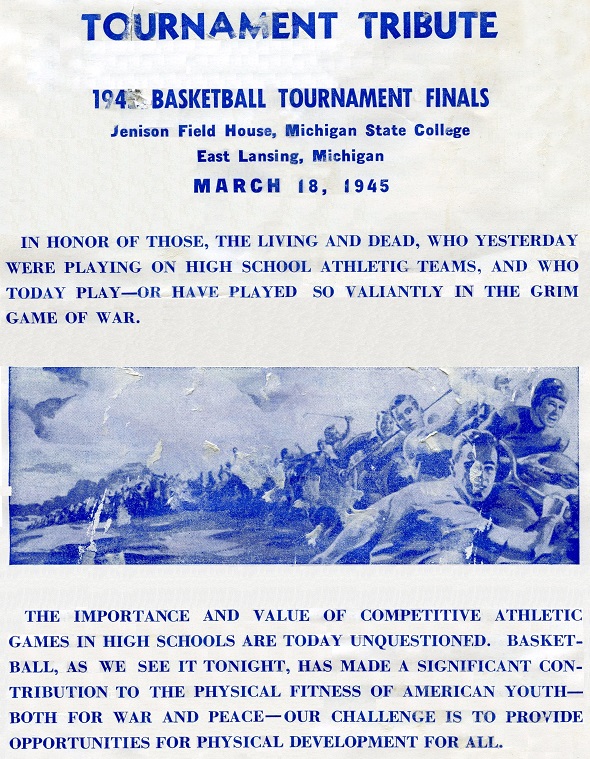
 Ron Pesch has taken an active role in researching the history of MHSAA events since 1985 and began writing for MHSAA Finals programs in 1986, adding additional features and "flashbacks" in 1992. He inherited the title of MHSAA historian from the late Dick Kishpaugh following the 1993-94 school year, and resides in Muskegon. Contact him at [email protected] with ideas for historical articles.
Ron Pesch has taken an active role in researching the history of MHSAA events since 1985 and began writing for MHSAA Finals programs in 1986, adding additional features and "flashbacks" in 1992. He inherited the title of MHSAA historian from the late Dick Kishpaugh following the 1993-94 school year, and resides in Muskegon. Contact him at [email protected] with ideas for historical articles.
PHOTOS: (Top) Grand Rapids Union was among "Area" boys basketball champions in 1943. (2) Lewis Forsythe, left, and Charles Forsythe were among leaders during the MHSAA's first decades (3) The Saginaw Arthur Hill yearbook for 1944 tells of fitness training undertaken by students. (4) Julian W. Smith served as interim MHSAA executive director while Charles Forsythe was serving in the military. (5) Flint Northern's Bill Hamilton earned all-state honors in 1942. (6) Western Michigan College was among hosts of 1943 Area tournaments. (7) Arthur Hill's yearbook celebrates the 1943-44 boys basketball championship. (8) Basketball Finals returned to Jenison Field House in 1945. (9) The MHSAA paid tribute to World War II veterans in its 1945 Basketball Finals program.

